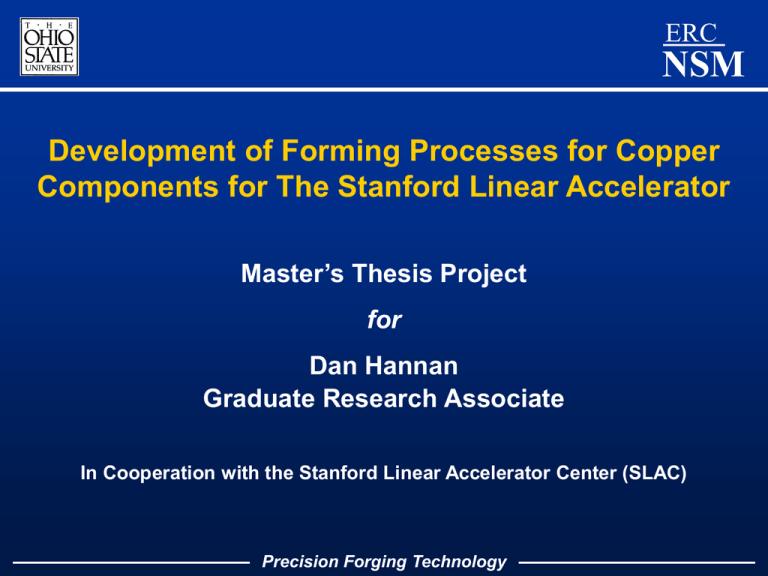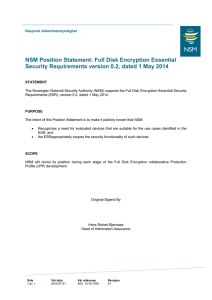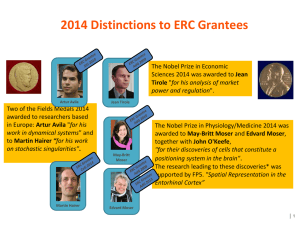Precision Forging Technology
advertisement

ERC NSM Title Development of Forming Processes for Copper Components for The Stanford Linear Accelerator Master’s Thesis Project for Dan Hannan Graduate Research Associate In Cooperation with the Stanford Linear Accelerator Center (SLAC) Precision Forging Technology Outline • Introduction – What is an accelerator cell? • Objectives • Approach • Flow stress measurement • Lubricant contamination tests • Future work Precision Forging Technology ERC NSM What is an Accelerator Cell? ERC NSM • An accelerator cell allows subatomic particles to achieve high energy and then collide with targets within an accelerator structure • Out of this interaction come many other subatomic particles that pass into detectors • From the information gathered in the detectors, physicists can determine properties of the particles and their interactions. • The higher the energy of the accelerated particles, the more closely one can probe the structure of matter. Precision Forging Technology Accelerator Cell Tolerances as low as .5 Microns Precision Forging Technology ERC NSM ERC Accelerator Cell *Cost estimate for cell fabrication without forging NSM Rough Machining Annealing Precision Machine Daimond Turn QC Cleaning Total Precision Forging Technology $23.38 $4.07 $20.70 $47.13 $1.27 $1.74 $98.29 24% 4% 21% 48% 1% 2% ERC Accelerator Cell NSM *Cost estimate for cell fabrication with forging Forge Annealing Precision Machine Daimond Turn QC Cleaning Shipping Total Precision Forging Technology $0.54 $0.50 $8.21 $4.02 $0.31 $0.44 $0.35 $14.37 4% 3% 56% 28% 2% 3% 2% Accelerator Cell SLAC’s Perspective • With the following assumptions: – 980,000 accelerator cells – Shop rate = $200.00/Hr = .06 cents/sec • Then every second saved during manufacturing of a single cell will result in savings of $54,000 for the entire lot of cells Precision Forging Technology ERC NSM Accelerator Structure 980,000 Total Cells Precision Forging Technology ERC NSM ERC NSM Precision Forging Technology Objectives ERC NSM • Investigation of surface contamination during forming of copper • Reduce the machining cost by forming to near net shape dimensions – Develop forming sequence – Tool design – Compensation for elastic deflection Precision Forging Technology Approach • Measurement of flow stress for copper • Lubricant contamination tests • Process design for copper accelerator cell Precision Forging Technology ERC NSM Flow Stress Measurement ERC NSM • Compression Test w/ Rastageav’s Specimens • Specimens coated with wax • Dies lubricated with Teflon sheets and Teflon spray • Load and displacement recorded Precision Forging Technology Flow Stress Measurement • Specimens to be manufactured by SLAC – 10 from sheet, as received – 10 from billet, as received – 10 from billet, stress relieved • No barreling can occur • Must correct for press deflection and temperature • Purpose: – To obtain accurate flow stress data for FEM simulations Precision Forging Technology ERC NSM Lubricant Contamination Tests ERC NSM • Contamination of formed surfaces is a major concern in the manufacturing of the SLAC particle accelerator cell • If the contamination is too deep into the surface of the part it will not be removed during the finish machining stage • Two different tests will be used to investigate contamination from the lubrication and the tool surface: – Single cup backward extrusion test – Ring test Precision Forging Technology Lubricant Contamination Tests ERC NSM • Specimens will be manufactured by SLAC • Candidate lubricants will be chosen by ERC/NSM and approved by SLAC • Common lubricants used in the forging of copper are: – Emulsions of fatty oils – mineral oils – Fatty oils – graphite – Graphite – grease • From the ring test, the coefficient of friction will be approximated Precision Forging Technology Lubricant Contamination Tests ERC NSM • The single cup backward extrusion test will produce higher pressures than the ring test • The single cup backward extrusion test will provide insight on the ability to deliver formed parts to the tolerances required • After the experiments are finished, specimens from both tests will be shipped to SLAC for inspection (lubricant contamination) Precision Forging Technology Future Work Process Design ERC NSM • Design of the as-formed geometry – ERC/NSM will find the geometry that limits that amount of machining required, but allows the part to be formed to the required tolerances – Elastic deflection of the tools and metal flow will be investigated • Development of preliminary forming sequence – ERC/NSM will design a forming sequence that produces the part to the required tolerances at minimal cost. – High forming pressures will be avoided to limit deflection of the tools Precision Forging Technology Future Work Process Design ERC NSM • Development of preliminary forming sequence (cont.) – The help of forging companies will be used to evaluate the feasibility of suggested forming sequences – FEM simulations will be used to test the forming sequence to see if the part can be formed without defects under reasonable loads. • Compensation for tool deflection • Investigate other copper components that could be formed to near net shape dimensions Precision Forging Technology Deliverables • Know how on forming processes to produce the accelerator cell • Cost reduction in the production of the accelerator cell • Tool drawings for the manufacture of forming tooling • Progress Reports, Final Report Precision Forging Technology ERC NSM






